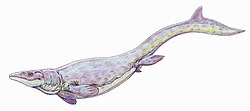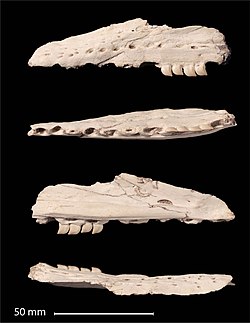| Mosasaurs from the Khouribga Phosphates |
|---|
| Genus | Species | Location | Time | Material | Notes | Images |
|---|
| Carinodens [29] [28] | C. acrodon | | Maastrichtian | | A small mosasaurine mosasaur with crushing teeth. [30] Fossils of all reported Carinodens species are very rare in Khouribga. [30] The dentition differs slightly between species, suggesting marginally different diets. [30] More fossil material is required to determine if both C. minalmamar and C. belgicus are present in the Khouribga Phosphates, as the present material is difficult to differentiate. [28] |  |
| C. belgicus | |
| C. minalmamar | |
| Eremiasaurus | E. heterodontus | | Maastrichtian | - Partial and subcomplete skeletons [30]
- Isolated teeth [30]
| A mosasaurine mosasaur with unusually heterodont teeth, including straight and conical anterior teeth, blade-like median teeth, and recurved posterior teeth. [30] A medium-sized (4.5–5 metres) predator and one of the more commonly found fossil mosasaurs in the Khouribga Phosphates. [30] |  |
| Gavialimimus [31] | G. almaghribensis | | Maastrichtian | - A complete skull [30]
- Isolated teeth [30]
| An unusual longirostrine plioplatecarpine mosasaur, measuring about 6 metres long. [30] Fossils of G. almaghribensis are very common in the Khouribga Phosphates. [30] |  |
| Globidens | G. phosphaticus | | Maastrichtian | | A durophagous mosasaurine mosasaur with specialized crushing teeth. [30] G. phosphaticus is known from Morocco only in the form of isolated teeth but more complete material from the species is known from Angola. [30] G. phosphaticus and G. simplex were of similar size but had slightly different teeth, suggesting marginally different diets. [30] |  |
| G. simplex | | Maastrichtian | - A partial skull [30]
- Isolated teeth [30]
|
| Halisaurus | H. arambourgi | | Maastrichtian | - Several skeletons [30]
- Isolated teeth [30]
| A halisaurine mosasaur, measuring about 3–4 metres long. [30] One of the most commonly found mosasaurs in Morocco. [30] |  |
| Igdamanosaurus | I. aegyptiacus | | Maastrichtian | | "Globidens aegyptiacus" was previously reported as present in the Khouribga Phosphates on the basis of isolated teeth. G. aegyptiacus was reclassified as Igdamanosaurus aegyptiacus in 1991 and differs from the globidensin material known from Morocco. [32] Moroccan fossils previously referred to G. aegyptiacus are now referred to G. phosphaticus. [32] | |
| Khinjaria [33] | K. acuta | | Maastrichtian | - A partial skull and vertebra [33]
| A plioplatecarpine mosasaur, known only from a single specimen. [30] Khinjaria possessed a unique skull and teeth morphology and might have been an ambush predator. [30] | |
| Liodon | L. anceps | | Maastrichtian | | "Mosasaurus (Leiodon) cf. anceps" was reported as present in Khouribga by Camille Arambourg (1952) based on isolated teeth. [34] Liodon anceps is now considered a nomen dubium. [30] Teeth previously referred to Liodon likely belong to Eremiasaurus heterodontus (small and slender specimens) and Thalassotitan atrox (other specimens). [30] | |
| Mosasaurus | M. beaugei | | Maastrichtian | - Skulls and mandibles [30]
- Isolated teeth [30]
| A large mosasaurine mosasaur, measuring about 8–10 metres long. [30] Relatively scarce compared to other mosasaurs of comparable size. Likely a local apex predator. [30] |  |
| Platecarpus | P. ptychodon | | Maastrichtian | - Isolated teeth and vertebrae [30]
| Platecarpus ptychodon is known only from isolated material. The fossils referred to P. ptychodon are treated either as non-diagnostic (in which case P. ptychodon is a nomen dubium ) or as belonging to Gavialimimus almaghribensis (in which case G. almaghribensis is considered a junior synonym of the new combination Gavialimimus ptychodon). [30] |  |
| Pluridens [35] | P. serpentis | | Maastrichtian | - Complete skulls with associated vertebrae [30]
- Isolated teeth [30]
| A large halisaurine mosasaur, also known from Niger and Nigeria. Measured about 5–6 metres long. [30] Pluridens is relatively uncommon in Morocco and distinguished from the closely related Halisaurus based on features in the skull and its larger size. [30] The teeth of Pluridens are identical to those of Halisaurus, only larger, and the two are thus difficult to differentiate in samples of isolated teeth. [30] |  |
| Prognathodon | P. currii | | Maastrichtian | | A large mosasaurine mosasaur. Prognathodon curii is known in Morocco only from isolated teeth and is comparably rare, with only about a dozen teeth identified. [30] The related species Prognathodon giganteus is also known from Morocco, though only from earlier lower Maastrichtian deposits in the Gantour Basin to the southwest of the Ouled Abdoun Basin. [30] [34] |  |
| Stelladens [36] | S. mysteriosus | | Maastrichtian | - A dentary fragment [30]
- Isolated teeth [30]
| A medium-sized mosasaurine with distinct, unique teeth structure with prominent serrated ridges. [30] Stelladens is a very scarce taxon in the Khouribga Phosphates. [30] Stelladens would have measured about 5 metres long and was probably a highly specialized predator. [30] |  |
| Thalassotitan [37] | T. atrox | | Maastrichtian | - Several skeletons [30]
- Isolated teeth [30]
| A large-bodied mosasaurine with powerful jaws and massive teeth, closely related to Prognathodon. [30] Fossils of Thalassotitan are comparably very common and it likely represented the largest local apex predator. [30] Fossils now referred to Thalassotitan were before its description often referred to as "Prognathodon nov. sp." [30] |  |
| Xenodens [38] | X. calminechari | | Maastrichtian | - A left maxilla with four teeth [30]
- A left maxilla with eight teeth [39]
| A small mosasaurine mosasaur with unusual, shark-like teeth. [30] The holotype of Xenodons was suggested to potentially be a forged specimen by Sharpe et al. (2024), [40] but Longrich et al. (2025) published a rebuttal based on CT scans of the holotype and another referred specimen, arguing for the validity of the genus. [39] |  |





















































